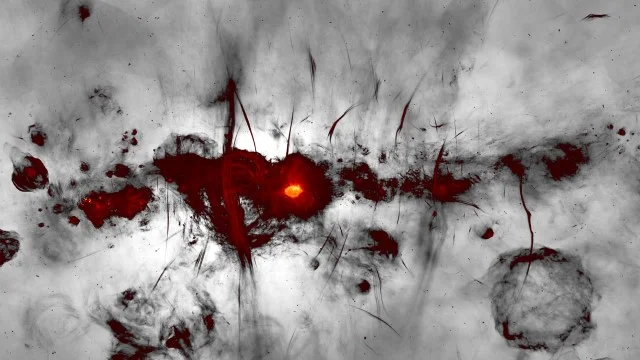
The South African Radio Astronomy Observatory (SARAO) has released a new MeerKAT telescope image of the centre of our Galaxy, showing radio emission from the region with unprecedented clarity and depth. The international team behind the work is publishing the initial science highlights from this image in The Astrophysical Journal. The lead author, Ian Heywood, is a Rhodes University Visiting Professor, and the second author, Isabella Rammala, is a Rhodes University PhD student.
The article is accompanied by a public release of the data to the worldwide astronomical community for their further scientific exploration.
The image captures radio emission from numerous phenomena, including outbursting stars, stellar nurseries, and the chaotic region around the 4 million solar mass supermassive black hole that lurks in the centre of our Galaxy, 25,000 light-years from Earth. Radio waves penetrate the intervening dust that obscures the view of this region at other wavelengths. MeerKAT’s innovative design, sensitivity, and geographical vantage point have been the keys to producing the remarkable image, which reveals new supernova remnants – the expanding shells of material left behind when massive stars end their lives explosively – including a rare almost-perfect spherical example, and provides astronomers with the best insight yet into the population of mysterious ‘radio filaments’ found nowhere else.
“I’ve spent a lot of time looking at this image in the process of working on it, and I never get tired of it,” says Dr Ian Heywood from the University of Oxford, Rhodes University and SARAO, and lead author of the study. “When I show this image to people who might be new to radio astronomy, or otherwise unfamiliar with it, I always try to emphasise that radio imaging hasn’t always been this way, and what a leap forward MeerKAT really is in terms of its capabilities. It’s been a true privilege to work over the years with colleagues from SARAO who built this fantastic telescope.”
This work represents the culmination of 3 years of detailed analysis of a survey conducted during the telescope’s commissioning phase. Those observations had already led to the iconic inaugural MeerKAT image in 2018 as well as the discovery of a pair of giant radio bubbles, evidence of an explosive outburst from the heart of our Galaxy several million years ago. Now, at last, the image is available in its full complexity for detailed study by astronomers worldwide.
The new image is based on a mosaic of 20 separate observations using 200 hours of telescope time covering an area of 6 square degrees (30 times the area of the full Moon). The data were consistently processed to deliver an angular resolution of 4 seconds of arc – the angle subtended by a tall person at a distance of 100 kilometres; or by the width of a fine human hair held at arm’s length – resulting in a 100 megapixel scientific image. Processing of the 70 terabytes of raw data was shared between two supercomputers in Cape Town, the Centre for High Performance Computing’s Lengau, and IDIA’s ilifu. Data processing and imaging were assisted by Rhodes / SARAO PhD student Isabella Rammala, who is investigating the compact radio sources in the image.
The highly-linear features pervading the image are radio-emitting magnetised threads. Up to 100 light-years long, these unique structures have defied a conclusive explanation for their origin since discovery over 35 years ago. MeerKAT has discovered many more such filaments than were previously known, and the new data release will allow astronomers to study these objects as a population for the first time. The first inroad into such work is presented in a companion paper in The Astrophysical Journal Letters.
“The best telescopes expand our horizons in unexpected ways,” says Dr Fernando Camilo, SARAO chief scientist. “It’s a testament to the skill and dedication of our South African colleagues who built MeerKAT that it’s making such remarkable discoveries in one of the most intensively studied corners of the radio sky. The image we’re sharing today is rich with scientific potential, and we very much look forward to further surprises as the astronomical community mines these data for years to come.”
PAPERS
‘The 1.28 GHz MeerKAT Galactic Center Mosaic’, by I. Heywood et al., accepted for publication in The Astrophysical Journal. A preprint of the paper can be found here.
‘Statistical Properties of the Population of the Galactic Center Filaments: The Spectral Index and Equipartition Magnetic Field’, by F. Yusef-Zadeh et al., accepted for publication in The Astrophysical Journal Letters. A preprint of the paper can be found here.
ABOUT MEERKAT AND THE SOUTH AFRICAN RADIO ASTRONOMY OBSERVATORY
MeerKAT, originally the Karoo Array Telescope, is a radio telescope inaugurated in 2018 consisting of 64 antennas spread over a diameter of 8 kilometres in the Northern Cape province of South Africa. It is the most sensitive telescope of its kind in the world and is a precursor to the Square Kilometre Array (SKA) radio telescope, to be built in South Africa and Australia within the coming decade.
The South African Radio Astronomy Observatory (SARAO), a facility of the National Research Foundation, is responsible for managing all radio astronomy initiatives and facilities in South Africa, including the MeerKAT telescope, and the geodesy and VLBI activities at the HartRAO facility. SARAO also coordinates the African Very Long Baseline Interferometry Network (AVN) for the eight SKA partner countries in Africa, as well as South Africa’s contribution to the infrastructure and engineering planning for the SKA. To maximise the return on South Africa’s investment in radio astronomy, SARAO is managing programmes to create capacity in radio astronomy science and engineering research, and the technical capacity required to support site operations.
For the original article and more images, please go to: https://www.sarao.ac.za/media-releases/new-meerkat-radio-image-reveals-complex-heart-of-the-milky-way

